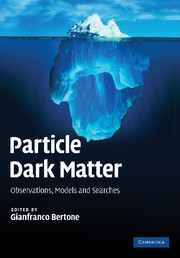Book contents
- Frontmatter
- Contents
- List of contributors
- Preface
- Acknowledgements
- List of symbols and abbreviations
- Part I Dark matter in cosmology
- 1 Particle dark matter
- 2 Simulations of cold dark matter haloes
- 3 Milky Way satellites
- 4 Gravitational lensing and dark matter
- 5 Dark matter at the centres of galaxies
- 6 Modified gravity as an alternative to dark matter
- Part II Candidates
- Part III Collider searches
- Part IV Direct detection
- Part V Indirect detection and astrophysical constraints
- References
- Index
4 - Gravitational lensing and dark matter
Published online by Cambridge University Press: 04 August 2010
- Frontmatter
- Contents
- List of contributors
- Preface
- Acknowledgements
- List of symbols and abbreviations
- Part I Dark matter in cosmology
- 1 Particle dark matter
- 2 Simulations of cold dark matter haloes
- 3 Milky Way satellites
- 4 Gravitational lensing and dark matter
- 5 Dark matter at the centres of galaxies
- 6 Modified gravity as an alternative to dark matter
- Part II Candidates
- Part III Collider searches
- Part IV Direct detection
- Part V Indirect detection and astrophysical constraints
- References
- Index
Summary
Introduction
Gravitational lensing effects arise from the modification of space-time metric produced by mass concentrations. Following an early prediction of General Relativity, gravitational fields deflect the light path of photons and modify the apparent flux and shape of astronomical sources. By observing gravitationally lensed images, cosmologists can probe dark matter almost ‘directly’. They can in principle examine it without the need to speculate on the distribution of matter inside the gravitational potential responsible for the light deflection, nor on its dynamical state and on its thermodynamical properties.
A most attractive application of gravitational lensing concerns the quest for dark matter candidates and for the properties of dark matter particles. Successful examples are the microlensing experiments (see [798] and references therein) carried out over the past decade to detect sub-stellar dark compact objects in the Galaxy. Similar searches for invisible cosmologically distributed compact objects have been carried out using microlensing on quasars [609]. These experiments set limits on compact dark objects (CDO) in the mass range 10−6M⊙ < m < 106M⊙ [1918] and prove they represent a fraction ΩM(CDO) < 0.1 of invisible mass in the Universe, if any.
Beside microlensing, other extragalactic gravitational lensing effects on quasars and extended sources (galaxies) can also probe dark matter. Although they are less frequent and more complex phenomena than microlensing, these lensing configurations provide much more detail on the lens and on the amount and distribution of matter inside.
- Type
- Chapter
- Information
- Particle Dark MatterObservations, Models and Searches, pp. 56 - 82Publisher: Cambridge University PressPrint publication year: 2010
- 2
- Cited by

